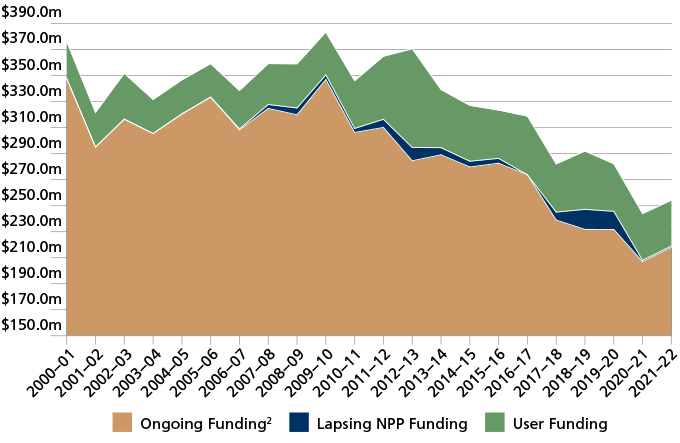1. ENVIRONMENTAL AND RESOURCE CONTEXT
ABS statistics and analysis informs economic policy, public sector policy, business decisions, research and innovation, and community debate and participation. The information remit set out in the Census Statistics Act 1905 and the Australian Bureau of Statistics Act 1975 encompasses collecting, compiling, analysing and disseminating statistics and related information.
Against the back drop of its legislation, the ABS needs to prioritise its activities taking into account available resourcing, changes in the economy and society to be measured, changing government and community priorities and changes in the authorising environment within which it operates.
1.1 ENVIRONMENTAL CONTEXT
In the provision of high quality statistics the ABS needs to constantly evaluate its program in light of the changing external environment. Over the course of 2018–19 a number of external developments will continue to inform the shape of the ABS work program.
In terms of what we measure, an evolving economy and society necessitates development of new statistical solutions, with our focus on better measuring productivity, the non-market sector and developing a richer picture of the dynamics of the labour market.
There is also increasing demand for evidence and data. At the same time, technological advances will enable increased access to a plethora of information (often instantaneously), against the back drop of growing public awareness and concern about the use of data.
The ABS is committed to balancing the secrecy of personal and business information with effective use of that data and meeting stakeholders’ expectations about ease of access to detailed information. Maintaining the trust of Australians who provide the ABS with their information is critical to producing high quality statistics.
The ABS will support the Australian Government’s commitment to reform the national data system by providing technical advice and assistance to the newly established National Data Commissioner (NDC) and other government entities. The ABS will advise on issues such as data quality, data integration, confidentialisation, high value datasets, and the use of the Five Safes Framework and Trusted User model for managing disclosure risk.
1.2 FINANCIAL CONTEXT FOR 2018–19
The level of ABS resources is a function of Government appropriation and user funding provided by stakeholders to deliver our data products and services.
In 2018–19, the ABS will receive an annual appropriation of $255 million and user funding of $46 million. This excludes funding for the Census of Population and Housing, which is appropriated separately, and Government investment in the Statistical Business Transformation Program (SBTP).
In 2018–19 the allocation of the ABS appropriation is approximately:
- 74 per cent for the production of official statistics comprising economic, environment, demographic and social programs and associated methodology and standards;
- 19 per cent for data collection, including phone, web and face-to-face interviews for business, household and the Labour Force Surveys; and
- Seven per cent for data integration, inclusive of $11.9 million in funding for the Data Integration Partnership for Australia (DIPA) initiative.
The majority of user funding (82 per cent of the $46 million in 2018–19) supports the social statistics program, with a small proportion supporting the industry, environment and agricultural statistical programs and some data integration. User funding is cyclical in nature and fluctuates according to the work program requirements of each individual revenue activity.
1.3 MEDIUM TERM FUNDING OUTLOOK
Stakeholders will always want more information than the ABS can afford to provide. This has always been the case given the high public value of information. The ABS substantially reviewed and prioritised our products and service offerings, in consultation with key stakeholders, to prepare the 2017–18 work program. That review confirmed the limited scope for reducing the statistical program; inevitably we cannot meet everyone’s preferences. See Box 1 for more details of our consultative mechanisms.
Over the past decade the need for prioritisation has become sharper as the ABS appropriation has reduced in real terms (see Chart 1). Significant statistical information is reliant on user funding, and there are a number of surveys that have not been undertaken now for over a decade such as the Time Use Survey and Mental Health Survey.
The ABS has achieved efficiencies by reducing its corporate overheads, reducing staffing numbers through several rounds of redundancies, and reducing its property footprint through activity based working and sharing with other government agencies.
Increased use of administrative and transactional data collected by other entities is reducing the cost of directly collecting some information. The ABS intends to do this more in the future. However, this is offset by rising costs of household surveys, data security protections, and qualified expert staff attraction and development.
The review of the 2017–18 Forward Work Program yielded small ongoing savings. The Department of Jobs and Small Business provided user funding for the continuation of the industrial disputes collection, the Department of Foreign Affairs and Trade for the annual international trade publication, and the Australian Competition and Consumer Commission assumed responsibility for the Internet Activity Survey. The following activities were ceased: Household Use of Technology; Sales of New Motor Vehicles; Statistical Clearance House; and Agricultural Land and Water Ownership Survey.
Sizeable future efficiencies will be dependent on changes in the way the ABS collects information, such as more eform collection, and the efficiency with which we compile and analyse this information, such as more automation of coding and editing. These efficiencies are dependent on the delivery of the SBTP.
CHART 1: REAL ABS OPERATING FUNDING1, 2000-01 TO 2021-22

Notes:
- Excludes funding for SBTP, the Census of Population and Housing and the Australian Marriage Law Postal Survey. Depreciation funding of approximately $30m per annum was removed from 2010–11 onwards.
- Base funding after WCI, Efficiency Dividend, efficiencies following SBTP and Whole-of-Government Savings. Includes ongoing NPP funding and offsets for property savings.
 Print Page
Print Page
 Print All
Print All